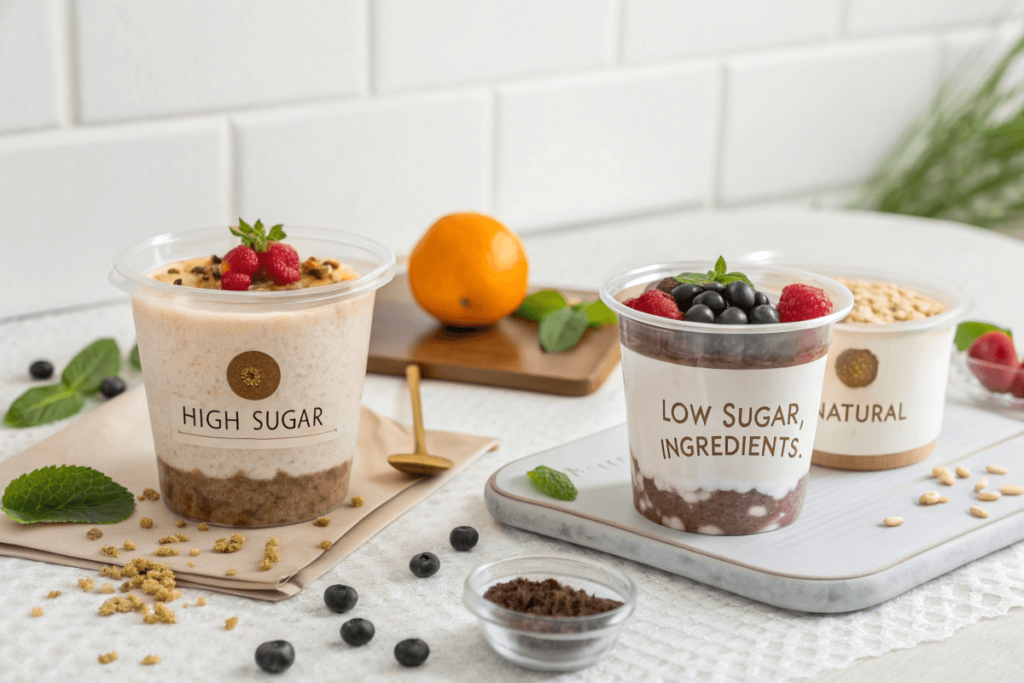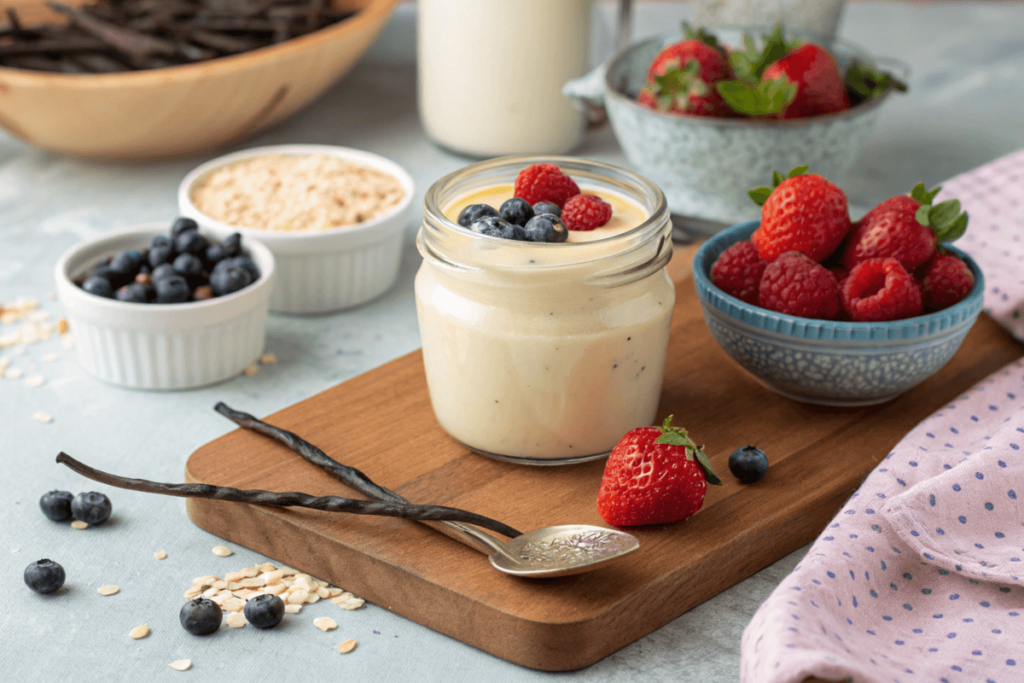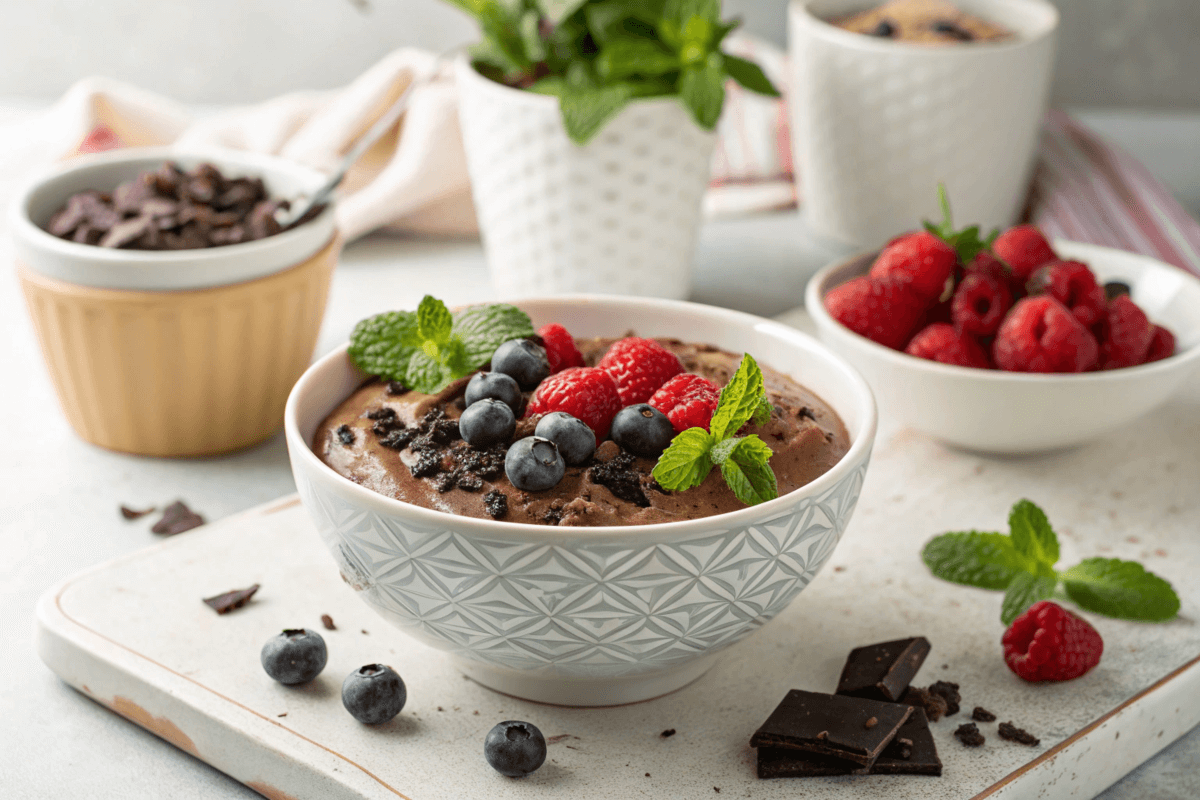Protein puddings are gaining popularity as a sweet, protein-packed snack, but are protein puddings healthy? Touted for their potential health benefits, they’re often seen as a convenient option for fitness enthusiasts and those seeking healthier dessert alternatives. This article explores the nutritional value, benefits, and potential downsides of protein puddings. You’ll also learn how to choose healthy options and even make your own at home. Whether you’re a fitness enthusiast or someone looking for guilt-free indulgence, this guide has everything you need to know.
Let’s dive into the details, starting with what protein puddings are and why they’re trending.
Introduction to Protein Puddings
Protein puddings are creamy, dessert-like snacks that contain added protein, making them a healthier alternative to traditional puddings. These snacks combine taste with nutritional value, often appealing to fitness enthusiasts, busy individuals, and those looking to satisfy their sweet cravings without overloading on sugar.
What Are Protein Puddings?
Protein puddings are typically made with ingredients like whey protein, casein, or plant-based protein sources mixed with milk, water, or other base liquids. The result? A rich, satisfying snack that’s not only delicious but also packs a protein punch. While traditional puddings are high in sugars and fats, protein puddings offer a better balance of macronutrients, making them a smart choice for those aiming to eat healthier.
Popularity of Protein Puddings: A Health Trend or Fad?
So, why the buzz around protein puddings? Fitness communities and health-conscious eaters have embraced them as convenient, low-calorie, high-protein treats. They’re great for refueling post-workout, curbing hunger between meals, or replacing sugary desserts. But are they just another fleeting health trend? That depends on their ingredients and how they’re incorporated into your diet. The key lies in choosing the right type of protein pudding—those with fewer additives and lower sugar content.
Protein puddings have come a long way from being niche products. They’re now widely available in grocery stores, online retailers, and even fitness-oriented cafes. The best part? You can easily whip up a batch at home to control the ingredients and tailor the flavors to your liking.
Nutritional Profile of Protein Puddings
Understanding the nutritional makeup of protein puddings is essential to determine their health benefits. Let’s delve into their key components.
Key Ingredients in Protein Puddings
Protein puddings typically contain:
- Protein Sources: Commonly used proteins include whey, casein, and plant-based options like soy or pea protein. These proteins aid in muscle repair and growth.
- Common Additives: To enhance flavor and texture, manufacturers often add sugars, sweeteners, and preservatives. It’s crucial to read labels to avoid excessive additives that may diminish the health benefits.
Macronutrient Breakdown: Balancing Carbs, Fats, and Protein
A well-balanced protein pudding should offer:
- Proteins: Essential for muscle maintenance and satiety.
- Carbohydrates: Provide energy; however, be cautious of high sugar content.
- Fats: Contribute to flavor and fullness; opt for those with healthy fat sources.
By examining the macronutrient distribution, you can select a pudding that aligns with your dietary goals.
Benefits of Protein Puddings
Incorporating protein puddings into your diet can offer several advantages.
Muscle Recovery and Growth
Consuming protein-rich foods post-exercise aids in muscle repair. Protein puddings provide a convenient and tasty option to support this process.
Curbing Hunger and Supporting Weight Loss
High-protein snacks increase feelings of fullness, potentially reducing overall calorie intake. Including protein puddings can help manage hunger and assist in weight management.
Providing Steady Energy Levels
The combination of proteins and carbohydrates in protein puddings offers a sustained energy release, preventing sudden blood sugar spikes and crashes.
In summary, protein puddings can be a beneficial addition to your diet, supporting muscle health, aiding in weight management, and providing consistent energy.
Are protein puddings healthy? When chosen wisely, they can be a nutritious and satisfying option.
Potential Downsides of Protein Puddings
While protein puddings offer several benefits, it’s essential to be aware of potential drawbacks to make informed dietary choices.

High Sugar Content: An Overlooked Issue
Many store-bought protein puddings contain added sugars to enhance flavor. Excessive sugar intake can lead to health issues like weight gain and increased blood sugar levels. To mitigate this, always check the nutrition label and opt for products with minimal added sugars. Choosing puddings sweetened with natural alternatives such as stevia or monk fruit can be a healthier option.
Artificial Additives and Their Effects
To improve taste, texture, and shelf life, manufacturers often include artificial additives in protein puddings. These can comprise artificial flavors, colors, and preservatives. Some individuals may experience adverse reactions to these substances, including digestive discomfort or allergic responses. Therefore, selecting products with natural ingredients and minimal additives is advisable.
Digestive Challenges: Dairy Sensitivities and Plant-Based Alternatives
Protein puddings made with dairy-based proteins like whey or casein may cause digestive issues for those with lactose intolerance or dairy sensitivities. Symptoms can include bloating, gas, and stomach cramps. If you experience such discomfort, consider plant-based protein puddings that use alternatives like pea or soy protein, which are generally easier to digest for individuals with dairy sensitivities.
Are protein puddings healthy? They can be, but it’s crucial to be mindful of these potential downsides to ensure they fit well within your dietary needs.
How to Choose Healthy Protein Puddings
Selecting a nutritious protein pudding involves careful consideration of its ingredients and nutritional content. Here are key factors to keep in mind:
Reading Nutrition Labels: A Step-by-Step Guide
- Check the Protein Content: Ensure the pudding provides an adequate amount of protein per serving, typically around 10-20 grams, depending on your dietary goals.
- Assess Sugar Levels: Look for products with low added sugars. Aim for less than 5 grams of sugar per serving to avoid unnecessary calorie intake.
- Evaluate Fat Content: Be cautious of high saturated fat levels. Opt for puddings with healthy fats and minimal saturated fats.
- Identify Additives: Scan the ingredient list for artificial additives. The shorter and more recognizable the ingredient list, the better.
Opting for Natural Ingredients
Choosing protein puddings made with natural, whole-food ingredients enhances their health benefits. Look for products that use:
- Natural Sweeteners: Such as stevia, monk fruit, or small amounts of honey.
- Whole Food Bases: Ingredients like Greek yogurt or almond milk provide additional nutrients and better digestibility.
- Natural Flavors and Colors: Derived from real foods instead of synthetic sources.
By focusing on these aspects, you can select protein puddings that align with your health objectives and dietary preferences.
For more delicious and healthy dessert options, check out our collection of healthy dessert recipes.
Are protein puddings healthy? With careful selection, they can be a nutritious addition to your diet.
Homemade Protein Pudding Recipes
One of the best ways to enjoy protein pudding is by making it yourself. By preparing it at home, you can control the ingredients, customize flavors, and avoid unnecessary additives. Here are two simple and delicious recipes to get you started.

Chocolate Protein Pudding Recipe
Ingredients:
- 1 cup milk (dairy or plant-based)
- 1 scoop chocolate protein powder
- 2 tablespoons unsweetened cocoa powder
- 1 tablespoon honey or maple syrup
- 1 teaspoon vanilla extract
- 1 tablespoon chia seeds (optional, for added thickness)
Instructions:
- In a mixing bowl, whisk together milk, protein powder, cocoa powder, honey, and vanilla until smooth.
- Stir in chia seeds if you prefer a thicker texture.
- Pour the mixture into small jars or bowls.
- Refrigerate for at least two hours or until set.
- Top with nuts, fruit, or a sprinkle of dark chocolate shavings for extra flavor.
Vanilla Protein Pudding Recipe
Ingredients:
- 1 cup Greek yogurt
- 1 scoop vanilla protein powder
- 1 tablespoon honey
- 1 teaspoon vanilla extract
- Fresh berries or granola for topping
Instructions:
- Combine Greek yogurt, protein powder, honey, and vanilla extract in a bowl.
- Mix until creamy and smooth.
- Divide the mixture into serving dishes.
- Chill in the refrigerator for at least one hour.
- Garnish with fresh berries or granola before serving.
Making protein pudding at home answers the question, Are protein puddings healthy? Homemade versions allow you to keep things clean, natural, and nutritious.
Is Protein Pudding Good for Weight Loss?
When consumed thoughtfully, protein pudding can support weight-loss goals. Its high protein content and satisfying texture make it an excellent addition to a balanced diet.
How Protein Puddings Aid Weight Management
Protein helps keep you full longer, which reduces cravings and snacking. By incorporating protein pudding as a snack or dessert, you can manage your appetite while still enjoying something sweet. Additionally, most protein puddings are relatively low in calories, making them a guilt-free treat.
Tips for Incorporating Protein Puddings Into Your Weight-Loss Diet
- Choose Low-Sugar Options: Excess sugar can derail your progress, so opt for puddings with less than 5 grams of sugar per serving.
- Pair With Nutrient-Rich Foods: Adding toppings like fresh fruit, nuts, or seeds can boost the nutritional value.
- Use Portion Control: Stick to one serving size to avoid overindulging.
- Replace High-Calorie Desserts: Swap out ice cream or cake with protein pudding for a healthier alternative.
So, are protein puddings healthy for weight loss? Absolutely, if you focus on portion control, natural ingredients, and low-calorie options. They can satisfy your sweet tooth without compromising your health goals.
Frequently Asked Questions (FAQs)
Here, we answer some of the most common questions people have about protein puddings. Whether you’re new to this snack or already a fan, these answers will provide clarity.
1. Are Protein Puddings Healthy for Kids?
Yes, protein puddings can be a healthier dessert or snack option for kids, as long as they are low in sugar and free from artificial additives. Look for puddings that use natural sweeteners and simple ingredients. Remember to keep the protein content moderate since children don’t need as much protein as adults.
2. Can I Eat Protein Pudding Every Day?
Absolutely! Protein puddings can be eaten daily if balanced with other nutrient-rich foods in your diet. Just ensure they are low in sugar and free from unnecessary additives. Eating too much, however, might lead to excess calorie intake, so moderation is key.
3. What’s the Best Time to Eat Protein Pudding?
Protein pudding is versatile and can be eaten as a snack, post-workout fuel, or even as a dessert. After a workout, it helps in muscle recovery, while as a dessert, it satisfies your sweet tooth in a healthier way.
4. Can I Make Protein Pudding Without Protein Powder?
Yes, you can! Alternatives like Greek yogurt, silken tofu, or nut butters provide natural protein sources. Simply mix them with milk, fruit, or cocoa to create a creamy, delicious pudding. Homemade versions are perfect for answering the question, Are protein puddings healthy?
Pros and Cons of Protein Puddings
Like any food, protein puddings have both benefits and potential drawbacks. Let’s break it down for you.
Pros of Protein Puddings
- High in Protein: They support muscle growth and repair, making them ideal for active individuals.
- Convenient and Versatile: Easy to prepare and suitable as a snack or dessert.
- Healthier Dessert Option: Lower in sugar compared to traditional puddings.
- Customizable: Can be tailored to fit dietary preferences by making them at home.
Cons of Protein Puddings
- High Sugar in Some Products: Store-bought options may have hidden sugars.
- Artificial Ingredients: Many contain additives that aren’t great for health.
- Not a Meal Replacement: Protein puddings are snacks, not substitutes for balanced meals.
- Digestive Sensitivities: Dairy-based options may cause discomfort for some individuals.
So, are protein puddings healthy? The answer lies in choosing the right product or making your own to enjoy their benefits while avoiding potential pitfalls. With mindful consumption, they can be a tasty and health-conscious addition to your diet.
Part 10: Conclusion and Final Thoughts
Protein puddings are more than just a passing health trend. They offer a tasty, versatile, and nutritious option for people looking to enjoy a high-protein snack or dessert. Whether you’re a fitness enthusiast, trying to lose weight, or simply seeking healthier alternatives to sugary treats, protein puddings can fit seamlessly into your diet when chosen wisely.
By asking, Are protein puddings healthy?, we’ve explored their nutritional profile, benefits, and potential drawbacks. The key takeaway is this: not all protein puddings are created equal. Opt for products with natural ingredients, low sugar content, and balanced macronutrients. Better yet, make your own at home for complete control over what you’re eating.
Enjoy them in moderation, pair them with nutrient-dense toppings like fresh fruit or nuts, and use them as part of a balanced diet. With these strategies, protein puddings can be a delightful and health-conscious addition to your lifestyle. So, the next time you’re craving something sweet, reach for a protein pudding and indulge—guilt-free!


1 thought on “Are Protein Puddings Healthy?”